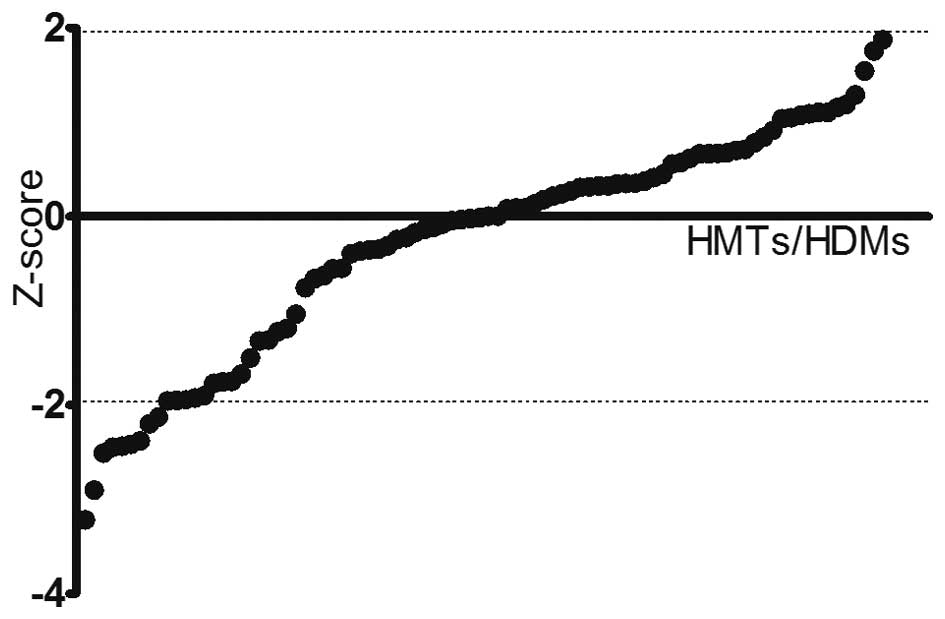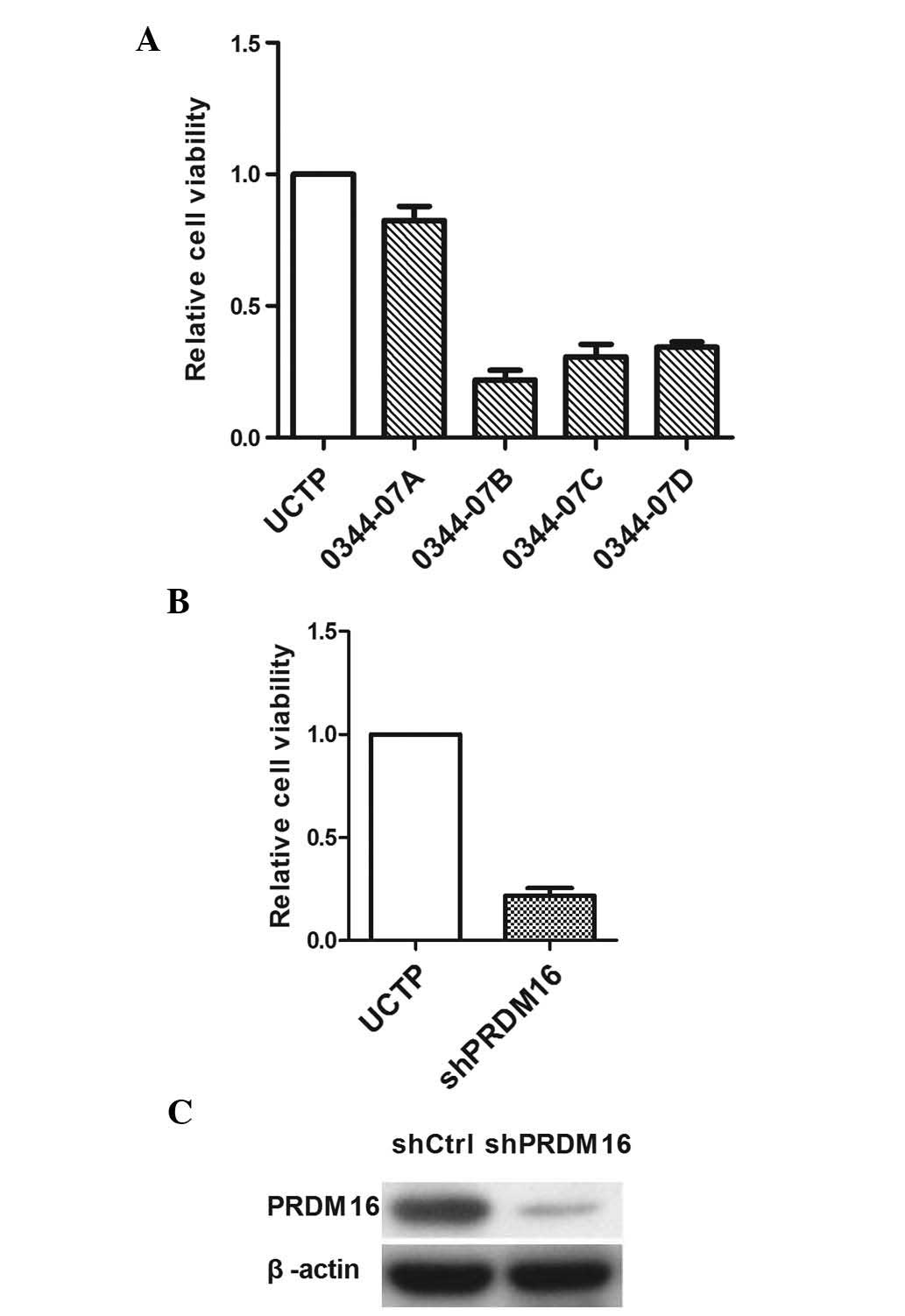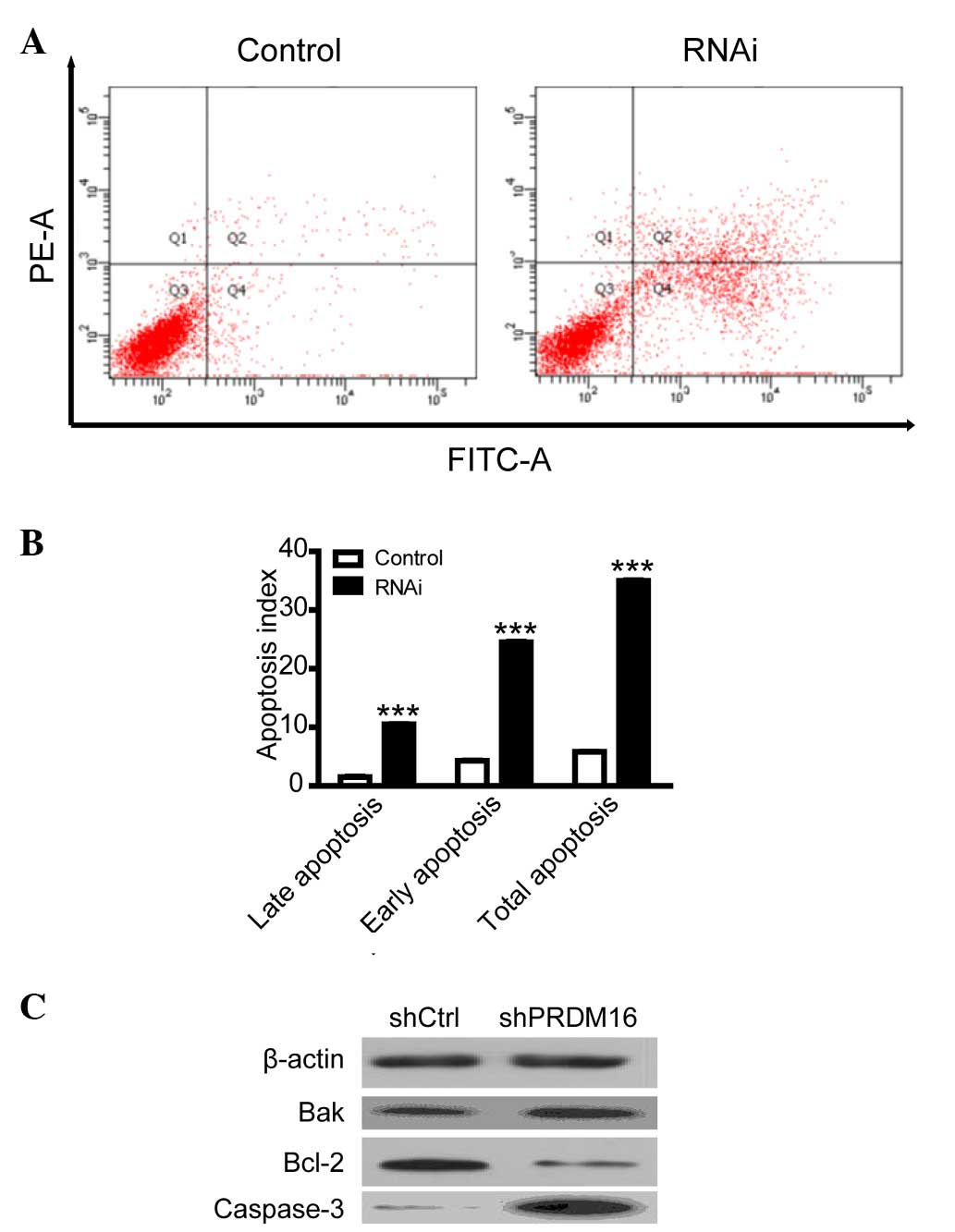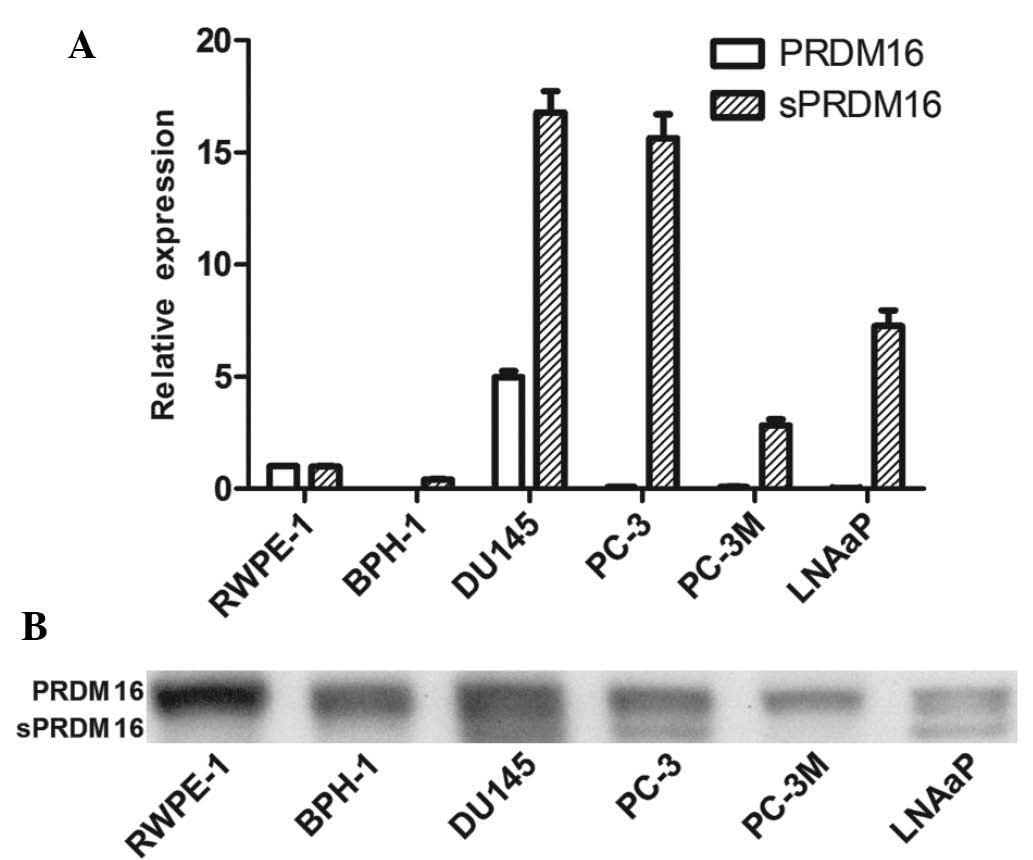PRDM16 is associated with evasion of apoptosis by prostatic cancer cells according to RNA interference screening
- Authors:
- Published online on: August 8, 2016 https://doi.org/10.3892/mmr.2016.5605
- Pages: 3357-3361
Abstract
Introduction
Prostate cancer (PCa) is the most common malignancy in males in western countries and the second leading cause of cancer-associated mortality (1). Long-range epigenetic activation (2) and long-range epigenetic silencing (3) have been discovered in the genome of PCa cells, which indicated there were structural re-arrangements in PCa. Post-translational histone modifications, which represent a classic epigenetic aberration, have been shown to participate in PCa metastasis and androgen-independent transition. A study on castration-resistant PCa patients revealed that the blockade of histone deacetylases re-sensitized PCa cells to androgen ablation therapy (4). Histone methylation, controlled by histone methyltransferases (HMTs) and histone demethylases (HDMs), was also proved to participate in PCa metastasis and androgen-independent transition. HMTs, such as CAM1 and EZH2, were found to be over-expressed in PCa, with EZH2 being regarded as a co-activator of the androgen receptor (AR), showing oncogenic activities in PCa (5). Following the discovery of lysine-specific histone demethylase 1A in 2004 (6), histone methylation was initially thought to be irreversible, while its interaction with the AR in vitro and in vivo and its promotion of AR-dependent transcription was demonstrated in 2005 (7). It has been indicated that histone modifications are involved in the regulation of early cell fate decisions, cell differentiation and tissue development, and are also linked with numerous of diseases, particularly cancer (4). HMTs and HDMs participate in a variety of processes which are aberrant in cancers, including DNA damage repair, cell replication and apoptosis (4,5). Altered expression of HMTs and HDMs has been reported to be associated with clinical and pathological outcomes of cancer and to be implicated in the formation of androgen-independent PCa, indicating that these enzymes may represent promising therapeutic targets for PCa.
However, the functions of HMTs and HDTs in cancers as well as the underlying molecular mechanisms have largely remained elusive. The present study performed an RNA interference screening using a lentivirus-directed small hairpin (sh) RNA library targeting all human HMTs and HDTs in order to systematically elucidate the function of HMTs and HDTs in PCa cell growth and viability. PRDM16 was identified to be associated with the evasion of PCa cells from apoptosis, and its spliced form, sPRDM16, was found to be aberrantly expressed in PCa cells.
Materials and methods
Cell culture, antibodies and shRNA library
The RWPE-1 prostate epithelial (PR) cell line, the BPH-1 benign prostate hyperplasia (BPH) cell line and the DU145, PC-3, PC-3M and LNCaP PCa cell lines were purchased from the American Type Culture Collection (Manassas, VA, USA) and maintained at 37°C in a humidified atmosphere containing 5% CO2. The cell culture media of DU145, PC-3, PC-3M, LNCaP, RWPE1, and BPH cell lines was RPMI-1640 (Gibco; Thermo Fisher Scientific, Inc., Waltham, MA, USA). The fetal bovine serum was purchased by Gibco (Thermo Fisher Scientific, Inc). Antibodies against PRDM16 (cat. no. ab106410; 1:500), B-cell lymphoma 2 (Bcl-2; cat. no. ab182858; 1:1,000), Bcl-2 homologous antagonist killer (Bak; cat. no. ab32371; 1:1,000), cleaved caspase-3 (cat. no. ab13847; 1:500) and glyceralde-hyde-3-phosphate dehydrogenase (GAPDH; cat. no. ab181602; 1:5,000) were purchased from Abcam (Cambridge, MA, USA). All the antibodies were polyclonal raised in rabbit. The customized lentiviral-mediated shRNA library targeting 88 HMTs and HDMs was purchased from 3D-HTS (Shanghai, China). Each gene was targeted by two pools of four distinct shRNA species with specificity for different sequences of the target transcript.
RNA interference (RNAi) screening
DU145 cells (were plated in 96-well plates at 3,000 per well and transfected using a virus concentration of MOI=30, with the shRNA library for 24 h. An 3-(4,5-dimethylthiazol-2-yl)-5-(3-carbo xymethoxyphenyl)-2-(4-sulfophenyl)-2H-tetrazolium (MTS) assay was then performed as described below. Cells were screened in independent triplicates. Four individual shRNA species which targeted each gene were then assessed in order to validate and narrow down the results of the primary screening. RNAi-mediated gene silencing was then confirmed by reverse-transcription quantitative polymerase chain reaction (RT-qPCR) and western blot analysis.
RT-qPCR
DU145 cells were seeded into six-well plates and transfected with shRNA for 96 h. TRIzol was used to extract the total RNA and complementary DNA was generated using a ReverTra Ace qPCR RT kit (Toyobo Co., Ltd., Osaka, Japan). A SYBR Green PCR kit (Takara Bio Inc., Otsu, Japan) was then used to amplify the cDNA by PCR. The thermocycling conditions used were, pre-denaturation at 94°C for 5 min, 30 cycles of denaturation at 94°C for 30 sec, annealing at 56°C for 30 sec and extension at 72°C for 30 sec, final step at 72°C for 20 min. The primers were purchased from Dingguo Changsheng Biotechnology, Co., Ltd. (Beijing, China) and the following sequences were used: PRDM16, forward (F) 5′-TTCTCTGGACGCTTGGTTGA-3′ and reverse (R) 5′-GAGGCCCTAGAGGTGGTTGAT-3′; PRDM16-L, F 5′-CAAGGAGGAGGAGAGAGATT-3′ and R 5′-CGGTTGGGCTCATACATA-3′; and sPRDM16 F 5′-TGCACACCCAGCAACACC-3′and R 5′-GCTGCGCTAGAGAAAAGCGT-3′. The expression of GAPDH was also evaluated to calculate the relative target gene expression. The 2−ΔΔCq method was used for quantification (8).
Western blot analysis
Cells cultured in six-well plates were lysed with 300 µl sodium dodecyl sulfate-polyacrylamide gel electrophoresis (SDS-PAGE) lysis buffer. The bicinchoninic acid protein assay (OriGene Technologies, Inc., Beijing, China) was used to evaluate the protein concentration. A total of 30 µg protein of each sample was subjected to 8% SDS-PAGE (OriGene Technologies, Inc.) and then transferred onto polyvinylidene difluoride membranes. Membranes were then blocked in 5% non-fat milk in Tris-buffered saline/Tween 20 for 1 h at 37°C, followed by incubation with the indicated antibodies for 1 h at 37°C. Subsequently, the membranes were incubated with horseradish peroxidase-conjugated secondary antibody (cat. no. ab6721; 1:300), and blots were visual-ized using enhanced chemiluminescence reagent (OriGene Technologies, Inc.).
Cell proliferation assay
Following transfection of DU145 cells with the shRNA library as described above, the transfection medium in each well was replaced with 100 µl cell culture medium. 20 µl One Solution Reagent (Promega Corp., Madison, WI, USA) containing 19 µl MTS and 1 µl phenazine methosulfate was added into each well, followed by incubation at 37°C for 1 h. The optical density value of the supernatant was then measured at 490 nm using a spectrophotometer.
Flow cytometry
DU145 cells were collected and washed with phosphate-buffered saline (PBS) following 120 h of transfection. They were centrifuged at 400 × g and washed twice. The cells were seeded at a density of 1.0×106 cells/ml and 1X Annexin-binding buffer was added. Alexa Fluor 488 Annexin V (OriGene Technologies, Inc., Beijing, China) and 100 µg/ml propidium iodide working solution were added to each 100 µl of cell suspension. The cells were incubated at room temperature for 15 min. Next, 400 µl 1X Annexin-binding buffer was added and mixed gently. The fluorescence emission was measured at 530 nm using a flow cytometer (FC 500 MCL/MPL, Beckman Coulter, Inc., Brea, CA, USA).
Statistical analysis
SPSS version 13.0 (SPSS, Inc., Chicago, IL, USA) and GraphPad Prism 5 (GraphPad Software Inc., California, USA) were used for the statistical analyses. Z-score and a Student's t-test were performed. P<0.05 was considered to indicate a statistically significant difference between values.
Results
RNAi screening for HMTs and HDMs associated with PCa cell viability
To identify HMTs and HDMs implicated in PCa cell viability, a systematic RNAi-mediated screening assay was performed. DU145 cells were transfected with an array of 176 shRNAs targeting a total of 88 HMTs and HDMs. After 24 h of transfection, the cell viability in each well was evaluated to assess the effects of each pool of shRNAs on the cell growth. Pools were classified as hits if the absolute value of the Z-score was >1.96 compared to the negative control (Fig. 1). A total of nine genes were identified by this screen with a bottom Z-score of −2.217 (PRDM16) and a top Z-score of −3.211 (FBXO11) (Table I).
Table IGenes identified to be associated with DU145 cell viability in the RNA interference screening. |
PRDM16 inhibition decreases DU145 cell viability
The present study next evaluated the effects of PRDM16 inhibition on the viability of DU145 cells and explored its implication in apoptosis. To exclude the possibility that the inhibition of DU145 viability was induced by the knockdown experiments due to off-target effects, each well of DU145 cells was transfected with one of four different shRNA lentiviral vectors. As three of the four lentiviral vectors reduced the cell viability by >70% (Fig. 2), the presence of an off-target effect could be excluded. The results revealed that 0034-07D exerted the highest inhibitory effect on DU145 cells; therefore, this shRNA was used in all subsequent experiments. PCR and western blot analyses confirmed a reduction of PRDM16 expression by 0034-07D at the mRNA and protein level.
PRDM16 inhibition upregulates DU145 cell apoptosis
To explore the mechanism by which PRDM16 regulates cell viability, flow cytometric analysis was used to evaluate the apoptotic rate of DU145 cells. The results indicated that inhibition of PRDM16 induced DU145 cell apoptosis (Fig. 3); suggesting that PRDM16 is involved in the evasion of apoptosis of PCa cells, while the study of its effects on cell proliferation exceeded the margin of the present study. To explore the mechanism by which PRDM16 regulates apoptosis, the expression of several apoptotic proteins was evaluated using western blot analysis. The results indicated that the increase of apoptosis after PRDM16 inhibition was parallelled with downregulation of the expression of the anti-apoptotic Bcl-2 and upregulation of the pro-apoptotic Bak and cleaved caspase-3.
sPRDM16/MEL1S has an oncogenic role in PCa
Next, the present study evaluated the expression of PRDM16/MEL1 and its spliced version, sPRDM16/MEL1S, in the RWPE-1 PE cell line, the BPH-1 BPH cell line and four prostate cancer cell lines, DU145, PC-3, PC-3M and LNCaP (Fig. 4). RT-qPCR showed that PRDM16/MEL1 levels were decreased in most PCa cell lines, while sPRDM16/MEL1S was enhanced compared with that in the PE cell line. Furthermore, western blot analysis showed that PRDM16/MEL1 was present in each cell line, while sPRDM16/MEL1S was only detected in three out of four PCa cell lines (DU145, PC-3 and LNCaP), which indicated an oncogenic role of sPRDM16/MEL1S in PCa.
Discussion
To the best of our knowledge, the present study was the first to use a RNAi screening-based approach to systematically assess the effects of all human HMTs and HDTs on PCa cell viability. By using this approach, nine genes associated with PCa cell viability were identified, of which FBOX11, PRMT2, MEN1, MLL, PRDM16 and SETD4 have already been reported to be abnormally expressed in various cancer types (9–14). The PRDM16 gene is rearranged in AML and MDS (13). Approximately 25% of primary prostate tumors that progress to metastasis have gained this at the MEN1 locus (11). SETD4 was important for breast carcinogenesis and may be a novel molecular target for the diagnosis and treatment of breast carcinoma (14). While JMJD7 and -8 were identified by the screening of the present study, JMJD2 family proteins are well known to be associated with a variety of cancer types, including PCa (15). Among the nine genes identified by the present study, MEN1 has been previously reported to be involved in the tumorigenesis of PCa (11), which indicated high accuracy of the screening performed and suggested that RNAi screening is a powerful tool to identify genes involved in cancer.
Furthermore, the present study revealed that PRDM16 inhibition decreased DU145 cell viability by increasing the apoptotic rate. To explore the underlying mechanisms by which PRDM16 regulates apoptosis, the expression of several apoptotic genes was evaluated using western blot analysis. The results revealed that RNAi of PRDM16 induced apoptosis by reducing the expression of Bcl-2 and by upregulating the expression of Bak. Furthermore, the induction of apoptosis was associated with activation of caspase-3 by its cleavage.
PRDM16 is a member of the family of PR domain-containing proteins, which consists of 17 members and is characterized by the PR domain with a variable number of Zn-fingers (16). They function as regulators of chromatin function and transcription factors which are involved in the determination of cell fate. PRDM16 serves important functions in adipose tissue differentiation, and has also been described as an oncoprotein in myelodysplastic syndrome, acute myelocytic leukemia, adult T-cell leukemia and gastric carcinoma (13,17,18). sPRDM16, an alternatively spliced form of PRDM16 lacking the PR domain, was described to be aberrantly expressed in AML and gastric carcinoma. sPRDM16, but not PRDM16, was able to prevent TGF-β-induced growth inhibition in mouse T cells (17,18). The present study provided the first evidence that sPRDM16 is aberrantly expressed in PCa cell lines (DU145, PC-3 and LNCaP), while its expression could not be detected in the RWPE-1 PE cell line and the BPH-1 BPH cell line. These results suggested that sPRDM16 may have an oncogenic function in PCa and may represent a novel therapeutic target.
The screening approach of the present study provided nine genes involved in the regulation of PCa cell viability. The detailed results on PRDM16, and previous results on MEN1 (11), which were among these nine genes, indicate that the other seven genes may also have oncogenic roles in PCa, which requires further study. As BOX11, PRMT2, MLL and SETD4 have been previously indicated to be linked with other cancer types, their association with PCa is likely (8,9,11,13). Furthermore, JMJD7 and -8 and PRDM10 are members of the JMJD and PRDM family, respectively indicating similar functions to those of JMJD2 (15) and PRDM16.
It has been previously suggested that histone methylation, controlled by HMTs and HDMs, occurs during PCa metastasis and androgen-independent transition. The present study indicated that nine HMT/HDM genes are involved in the regulation of PCa cell viability, and that the inhibition of PRDM16 decreased DU145-cell viability via enhancement of the apoptotic rate. sPRDM16, an alternatively spliced form of PRDM16 lacking the PR domain, was identified to be overexpressed in three out of four PCa cell lines. These results suggested that sPRDM16 has an oncogenic role in PCa. While MEN1 has been previously reported to be associated with PCa, the likely oncogenic roles of the other seven genes, which have been partly indicated in other types of cancer, remain to be examined by further studies.
Acknowledgments
The present study was funded by a project supported by the Province-Ministry Incubation Program (no. 2014PYA004), Appropriate Technical Transformation of Zhejiang province (nos. 2013ZHB001 and 2014ZHB001) and the Natural Science Funds Of Zhejiang Province (no. LY16H160034).
References
|
Siegel RL, Miller KD and Jemal A: Cancer statistics, 2015. CA Cancer J Clin. 65:5–29. 2015. View Article : Google Scholar : PubMed/NCBI | |
|
Bert SA, Robinson MD, Strbenac D, Statham AL, Song JZ, Hulf T, Sutherland RL, Coolen MW, Stirzaker C and Clark SJ: Regional activation of the cancer genome by long-range epigenetic remodeling. Cancer Cell. 23:9–22. 2013. View Article : Google Scholar | |
|
Coolen MW, Stirzaker C, Song JZ, Statham AL, Kassir Z, Moreno CS, Young AN, Varma V, Speed TP, Cowley M, et al: Consolidation of the cancer genome into domains of repressive chromatin by long-range epigenetic silencing (LRES) reduces transcriptional plasticity. Nat Cell Biol. 12:235–246. 2010.PubMed/NCBI | |
|
Crea F, Sun L, Mai A, Chiang YT, Farrar WL, Danesi R and Helgason CD: The emerging role of histone lysine demethylases in prostate cancer. Mol Cancer. 11:522012. View Article : Google Scholar : PubMed/NCBI | |
|
Albert M and Helin K: Histone methyltransferases in cancer. Semin Cell Dev Biol. 21:209–220. 2010. View Article : Google Scholar | |
|
Shi Y, Lan F, Matson C, et al: Histone Demethylation Mediated by the Nuclear Amine Oxidase Homolog LSD1. Cell. 119:941–953. 2004. View Article : Google Scholar : PubMed/NCBI | |
|
Metzger E, Wissmann M, Yin N, Müller JM, Schneider R, Peters AH, Günther T, Buettner R and Schüle R: LSD1 demethylates repressive histone marks to promote androgen-receptor-dependent transcription. Nature. 437:436–439. 2005.PubMed/NCBI | |
|
Livak KJ and Schmittgen TD: Analysis of relative gene expression data using real-time quantitative PCR and the 2(-Delta Delta C(T)) method. Methods. 25:402–408. 2001. View Article : Google Scholar | |
|
Duan S, Cermak L, Pagan JK, Rossi M, Martinengo C, di Celle PF, Chapuy B, Shipp M, Chiarle R and Pagano M: FBXO11 targets BCL6 for degradation and is inactivated in diffuse large B-cell lymphomas. Nature. 481:90–93. 2012. View Article : Google Scholar : | |
|
Baldwin RM, Morettin A, Paris G, Goulet I and Côté J: Alternatively spliced protein arginine methyltransferase 1 isoform PRMT1v2 promotes the survival and invasiveness of breast cancer cells. Cell Cycle. 11:4597–4612. 2012. View Article : Google Scholar : PubMed/NCBI | |
|
Paris PL, Sridharan S, Hittelman AB, Kobayashi Y, Perner S, Huang G, Simko J, Carroll P, Rubin MA and Collins C: An oncogenic role for the multiple endocrine neoplasia type 1 gene in prostate cancer. Prostate Cancer Prostatic Dis. 12:184–191. 2009. View Article : Google Scholar | |
|
Angelova S, Jordanova M, Spassov B, Shivarov V, Simeonova M, Christov I, Angelova P, Alexandrova K, Stoimenov A, Nikolova V, et al: Amplification of c-MYC and MLL genes as a marker of clonal cell progression in patients with myeloid malignancy and trisomy of chromosomes 8 or 11. Balkan J Med Genet. 14:17–24. 2011.PubMed/NCBI | |
|
Duhoux FP, Ameye G, Montano-Almendras CP, et al: PRDM16 (1p36) translocations define a distinct entity of myeloid malignancies with poor prognosis but may also occur in lymphoid malignancies. Br J Haematol. 156:76–88. 2012. View Article : Google Scholar | |
|
Faria JA, Corrêa NC, de Andrade C, et al: SET domain-containing protein 4 (SETD4) is a newly identified cytosolic and nuclear lysine methyltransferase involved in breast cancer cell proliferation. J Cancer Sci Ther. 5:58–65. 2013.PubMed/NCBI | |
|
Berry WL and Janknecht R: KDM4/JMJD2 histone demethylases: Epigenetic regulators in cancer cells. Cancer Res. 73:2936–2942. 2013. View Article : Google Scholar : PubMed/NCBI | |
|
Pinheiro I, Margueron R, Shukeir N, Eisold M, Fritzsch C, Richter FM, Mittler G, Genoud C, Goyama S, Kurokawa M, et al: Prdm3 and Prdm16 are H3K9me1 methyltransferases required for mammalian heterochromatin integrity. Cell. 150:948–960. 2012. View Article : Google Scholar : PubMed/NCBI | |
|
Yoshida M, Nosaka K, Yasunaga J, Nishikata I, Morishita K and Matsuoka M: Aberrant expression of the MEL1S gene identified in association with hypomethylation in adult T-cell leukemia cells. Blood. 103:2753–2760. 2004. View Article : Google Scholar | |
|
Takahata M, Inoue Y, Tsuda H, Imoto I, Koinuma D, Hayashi M, Ichikura T, Yamori T, Nagasaki K, Yoshida M, et al: SKI and MEL1 cooperate to inhibit transforming growth factor-beta signal in gastric cancer cells. J Biol Chem. 284:3334–3344. 2009. View Article : Google Scholar |













